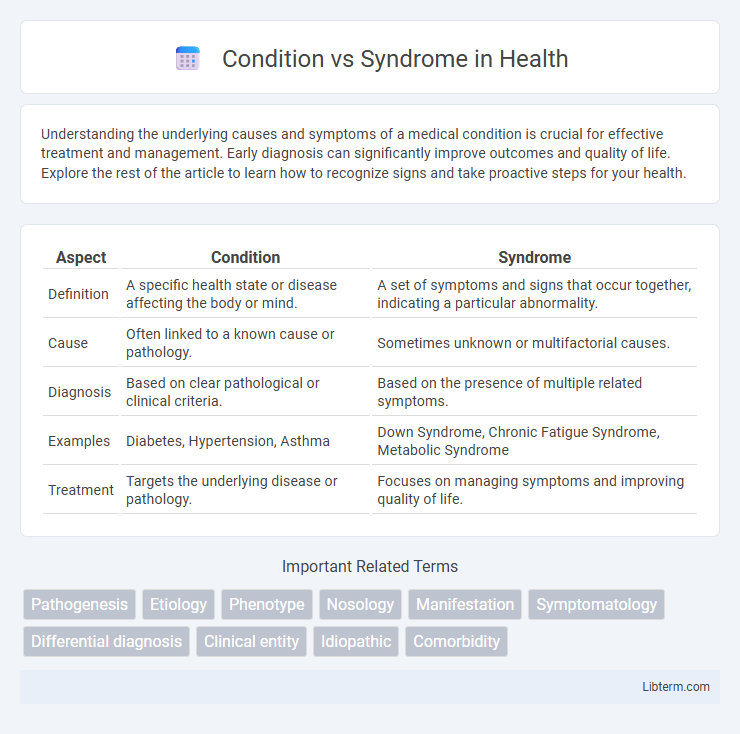Understanding the underlying causes and symptoms of a medical condition is crucial for effective treatment and management. Early diagnosis can significantly improve outcomes and quality of life. Explore the rest of the article to learn how to recognize signs and take proactive steps for your health.
Table of Comparison
| Aspect | Condition | Syndrome |
|---|---|---|
| Definition | A specific health state or disease affecting the body or mind. | A set of symptoms and signs that occur together, indicating a particular abnormality. |
| Cause | Often linked to a known cause or pathology. | Sometimes unknown or multifactorial causes. |
| Diagnosis | Based on clear pathological or clinical criteria. | Based on the presence of multiple related symptoms. |
| Examples | Diabetes, Hypertension, Asthma | Down Syndrome, Chronic Fatigue Syndrome, Metabolic Syndrome |
| Treatment | Targets the underlying disease or pathology. | Focuses on managing symptoms and improving quality of life. |
Understanding the Terms: Condition vs Syndrome
A condition refers to any medical state that affects normal body functions, often with identifiable causes and symptoms, while a syndrome is a collection of signs and symptoms that consistently occur together and characterize a particular abnormality or disease. Conditions can be singular or broad in nature, whereas syndromes represent specific patterns of clinical features without necessarily a single known cause. Understanding these terms helps healthcare providers diagnose and manage patient health by distinguishing between isolated disorders and symptom clusters requiring holistic evaluation.
Defining a Medical Condition
A medical condition refers to any abnormal state of health that may involve a disease, disorder, injury, or syndrome, characterized by specific signs and symptoms impacting normal body functions. Conditions can be acute or chronic and often require diagnosis based on clinical evaluation, laboratory tests, and imaging studies. Unlike syndromes, which represent a collection of symptoms and signs without a definitive underlying cause, conditions may have well-defined etiologies and pathophysiological mechanisms.
What Constitutes a Syndrome?
A syndrome constitutes a collection of signs and symptoms that consistently occur together, characterizing a specific abnormality or condition. Unlike a singular medical condition defined by one clear cause or pathology, a syndrome represents a pattern of multiple clinical features without necessarily implying a definitive etiology. Identifying a syndrome helps clinicians recognize distinct diagnostic categories for patient assessment and management.
Key Differences Between Condition and Syndrome
A condition refers to a specific medical state characterized by identifiable symptoms or abnormalities affecting an individual, often with a clear cause or diagnosis. A syndrome, however, encompasses a group of related symptoms and signs that occur together but may not have a single identifiable cause, making it a broader clinical concept. The key difference lies in conditions being distinct, diagnosable health issues, while syndromes represent a collection of symptoms that describe a pattern without necessarily specifying the underlying disease.
Common Misconceptions: Condition vs Syndrome
A common misconception is that conditions and syndromes are interchangeable terms; however, a condition refers to any health issue with specific symptoms or causes, while a syndrome represents a set of symptoms that consistently occur together, often without a known cause. Conditions can be singular or isolated health problems, whereas syndromes are characterized by a collection of related signs and symptoms, reflecting a broader clinical picture. Understanding this distinction is crucial for accurate diagnosis and treatment planning in medical practice.
Causes and Origins: How They Develop
A condition often refers to a specific state of health with identifiable causes such as infections, genetic mutations, or lifestyle factors, leading to a distinct pathology. A syndrome arises from a combination of symptoms and signs without a single known cause, frequently resulting from complex interactions of genetic, environmental, and physiological factors. Understanding the origins helps differentiate conditions with clear etiologies from syndromes characterized by multifactorial development.
Diagnosis: Identifying Conditions vs Syndromes
Diagnosis of a condition typically involves identifying a specific, well-defined disease or disorder based on standardized clinical criteria, laboratory tests, or imaging results. In contrast, diagnosing a syndrome requires recognizing a consistent group of symptoms and signs that occur together without necessarily pinpointing a single underlying cause. Medical professionals rely on pattern recognition and symptom clusters to differentiate syndromes from isolated conditions, guiding subsequent investigations and treatment plans.
Examples of Conditions and Syndromes
Conditions such as asthma, diabetes, and hypertension represent specific medical states characterized by distinct symptoms and causes. Syndromes like Down syndrome, metabolic syndrome, and carpal tunnel syndrome involve a collection of signs and symptoms that occur together and characterize a particular abnormality or disease. Both conditions and syndromes require proper diagnosis and treatment tailored to their unique clinical presentations.
Treatment Approaches: Condition vs Syndrome
Treatment approaches for a medical condition typically target a specific cause or pathology, allowing for focused interventions like medication, surgery, or lifestyle changes. In contrast, syndrome management involves addressing a group of symptoms without a single identifiable cause, often requiring multidisciplinary care and symptom-based therapies. Effective syndrome treatment emphasizes symptom relief and improving quality of life, while conditions aim for curing or controlling the underlying disease.
Importance of Accurate Terminology in Healthcare
Accurate terminology in healthcare is crucial for effective diagnosis, treatment, and communication, as conditions refer to specific medical states with identifiable causes while syndromes describe groups of symptoms without a singular known cause. Mislabeling can lead to improper treatment plans and hinder patient outcomes. Clear differentiation ensures precise medical records, enhances interdisciplinary collaboration, and supports targeted research initiatives.
Condition Infographic

 libterm.com
libterm.com